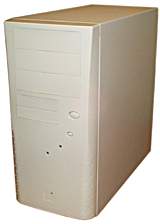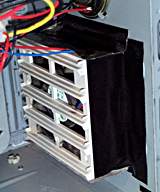
AOpen HX 45 midi-tower PC case
Review date: 28 February 1999.Last modified 03-Dec-2011.
For some people, there's a definite Freudian element to their computer case selection. Not to put too fine a point on it, they buy big ones. Great big tower cases with zillions of drive bays, despite the fact that they don't actually have zillions of drives to put into them. Some people even buy server cases, which often have optional caster wheels, because moving them any other way single handed is an open invitation to hiatus hernia.
Frankly, I think this is pretty goofy. Practically nobody actually needs a case big enough to house a family of four. But I also don't think it's a good idea to go too far the other way and buy a dinky little mini-tower case - especially not the super-cheap ones that so many low cost clones come in.
The alternative is a "midi-tower", a case with enough room for all but the most stacked computer systems, but without the bulk of a full tower. The AOpen HX 45 is one of the most popular cases among makers of quality clones, and it's easy to see why. It's good, and it's fairly cheap - about $170 retail (Australian dollars) including the power supply. You can get cases much cheaper than this - any number of mini-tower cases with a power supply are available for less than $100 Australian retail - but I've never quite grasped why people are happy to spend well over a thousand dollars on their PC, but baulk at another hundred bucks for a decent case.
The HX 45 is best described as a "mini midi-tower" case; it's got almost as many drive bays and all the other features of any other ordinary midi-tower case, but it stands a few inches shorter and is a bit wider.
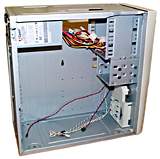
Inside, it's all nice smooth rolled edges. The
standard power supply is a 235 watt AOpen ATX unit; the case is also available
with a 200 watt PS/2 PSU.
I've just traded up to an HX 45 for the computer I'm typing this on. The case I had beforehand was bigger, but served as a practically textbook example of what's wrong with cheap midi-towers. Even a cheap midi-tower is better than pretty much any mini-tower, but a crummy one is still a pain.
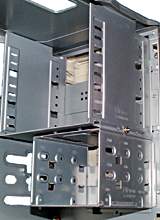
Three 5.25" bays, three 3.5". Many midi-tower cases
have one more 3.5 inch bay, but this is perfectly adequate for almost all
users.
My old case had a nifty sliding door on the front that could cover all of the drives and buttons. That was its only good feature. It had sharp edges that lacerated me, an insane lip over the expansion card screws so I couldn't get a screwdriver in there properly and, most annoyingly, sliding side panels that I needed a mallet to remove. When I first got the thing, I assumed the side panel clips would loosen with age. Uh-uh. If anything, the bleeding things got tighter. They were tricky to line up properly when replacing the panels, too. That old case has been retired, and there is much rejoicing.
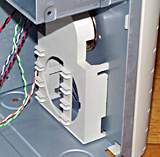
The standard front fan mount. The slotted things
are guides for the ends of full length expansion cards, which these days
are seen about as often as pterodactyls. Nonetheless, pretty much every
case has the holding slots for them. Like most front fan mounts, this one
is pretty lousy; to see what I did instead, click
here.
Dimensions
The old case was normal midi-tower sized - roughly 490 by 190 by 430mm (19 by 7.5 by 17 inches), including the front panel. The HX 45 is rather smaller - 410 by 200 by 430mm (16 by 8 by 17 inches) - but sacrifices only one 3.5 inch drive bay in interior capacity. It's got twin fan mounts just like every other decent midi-tower, and three 5.25 and three 3.5 inch bays. All of the 5.25" bays and two of the 2.5" bays have front panel cutouts. The 3.5 inch bays are a removable cradle that's held in place with one screw; there's a hole for another screw if you want really solid mounting.
Features

Inside, it's all nice smooth rolled edges. The
standard power supply is a 235 watt AOpen ATX unit; the case is also available
with a 200 watt PS/2 PSU.
The HX 45 is made from 1mm steel throughout. Most of the fasteners are pop rivets, so you can't dismantle the case completely, but I don't know why you'd want to. Unlike bargain basement cases, this one has rolled edges throughout, so you can work on it without cutting yourself to ribbons (Cheap PC Case Injuries are very similar in nature to Car Stereo Installation Injuries; plain stamped metal always has knife-sharp edges on the cutouts). The rolled edges not only make the case painless to work on, but also strengthen it - unlike many cheap cases, the HX 45 makes an excellent BGA (Butt to Ground Adaptor - anything not designed as a chair which is used as one is a BGA).
There's a nice handle cutout in the top of the HX 45 frame - again, with rolled edges, so you can use it as a handle without your severed fingers falling onto the motherboard. There are also cooling holes at the back above the cards, and along the bottom of the left hand side of the lid. These work very well if you fit a big ferocious front fan, which I did - see my HX 45 hacking project here - but they also help even if you have only the power supply fan running, since they allow more fresh air to be drawn over the motherboard and expansion cards.
The HX 45 uses the same U-shaped one-piece lid, fastened at the back with four screws, as pretty much every mini-tower on the market. This sort of cover is great for regular PCs where you don't care about having a lockable case, but just want quick and simple access to the guts of the computer. On larger cases a U-shaped lid becomes cumbersome and removable side panels work better, but the HX 45's lid works fine.
The front panel has interesting sculpted edges and rounded buttons, but isn't a masterpiece of modern design. No matter - it does the job. There's no "standby" or "turbo" switch and no matching LED, but pretty much nobody uses these so it's no great loss. For much the same reason, I doubt most buyers will care very much about the lack of a security keyswitch. The panel clicks into the front of the case with snap-lock tabs, and also has two retaining screws, so it won't pop off when you're carrying the box around.
On the bottom face of the front panel is the usual air intake slot, feeding through to the more-steel-than-holes grille for the optional front fan. Like most front fan mounts, the HX 45's holds the fan a little way back from the grille and leaks around the edges like a sieve. I still recommend you get a front fan, since any extra ventilation is better than none, but you should at the very least seal around the edges of the fan mount cradle with cloth-backed duct tape (often referred to as "Gaffa" tape in Australia, though the Gaffa brand stuff is actually inferior to Nashua 357 tape, which is what all the real gaffers use).
This is not the HX 45 fan cradle - it's the cradle from my old case. But it illustrates the sealing principle. I ditched the HX 45's cradle completely and cut a hole for a 120mm mains fan; read about this project here.
The back has seven expansion slots, so motherboards with the common combination of three ISA, three PCI, one ISA/PCI shared and one AGP slot will fit. The slots have neat press-in covers which don't need to be secured with a screw and can be popped out with a screwdriver. Many cheap cases have simple press-out covers for unused slots that can't be replaced. The case accepts ATX and Baby AT motherboards, so you can install your antique 486 board if you want.
Two back panel inserts are provided with the HX 45, with the one that fits most current ATX boards, including my Asus P2B, pre-fitted. The inserts are held in place with a screw, not just snapped in, and there are push-out covered holes for Baby AT motherboard connectors as well.
The standard power supply for the HX 45 is an AOpen 235 watt ATX unit with the conventional but not-according-to-ATX-specification outward-blowing fan. The case is also available with a 200 watt PS/2 PSU. If you're building a stacked system, a 300 watt PSU is a good investment; get it swapped for you when you buy the case and it should only cost you a little more. But again, for most users, 235 watts is plenty.
Like all cases, the HX 45 comes with a little bag of screws and motherboard mounts and so on; everything is provided, there are plenty of spares, and there's even a little cable tie for the switch and LED cables. These, by the way, are clearly marked (albeit according to the odd white-for-negative standard that's becoming popular for some reason), but the hard disk LED connector is a four pin plug with only two pins connected, for some reason. On my P2B motherboard this isn't a problem - you just plug the two connected pins into the two pin header and leave the rest of the plug hanging. Motherboards with the hard disk pin header in the middle of other connectors will require you to snip off the unused piece of plug.
All of the case parts and hardware are explained in the accompanying double-sided exploded diagram and instruction sheet, most of which is almost written in English.
Overall
This is an excellent case for the money, and will suit most users down to the ground.
Pros: |
Cons: |
|
|
